Amy Shojai's Blog, page 124
December 25, 2012
Why Tabby Wears An M–A Christmas Cat Story
Happy Christmas! I just returned from a visit to Indiana to visit my family and I know many of y’all may also be traveling this week. Whether you’re traveling by car with your cats or traveling with your dogs and decide to stay in a hotel, I hope you and your pets will be helped by the behavior tips. Maybe you’ve decided to leave Kitty with a pet sitter or your dog at a boarding facility while you visit Grandma—I’ve even provided an explanation of, and tips for solving that worrisome cat snubbing behavior when you get home.
Don’t forget to give pets gifts for the holidays! Your cats and dogs will return the favor—here’s the kind of doggy gifts as well as gifts cats give, and why. I’m taking the rest of the week off from blogging, but will be back New Year’s Eve with more bling-icity and pet-astic posts. Before I go, as has become the tradition on the blog (and in my PETiQuette newspaper column), I’ve shared a favorite Christmas story.
This touching legend, included in Complete Kitten Care, tells the story of a simple Tabby cat, and her gift on the very first Christmas day to a special mother and child. Enjoy!
Please be safe traveling back home. May your holidays be blessed.
Why Tabby Wears An M
There was no snow that night in Bethlehem. Instead, the small cat watched a star-spangled sky from her perch in the window of a stable. She liked the stable, for it was a warm safe place to raise her furry babies, and the innkeeper sometimes left scraps out for her to nibble. Tabby wasn’t particularly distinctive, and most humans didn’t look at her twice. After all, her short gray/black fur was quite common. But Tabby’s striped coat hid a heart bigger than cats twice her size.
This night, though, Tabby was out of sorts, for she’d not been able to hunt and catch dinner. Travelers had poured into town for days, so noisy they disturbed decent cat-folks’ rest. Why, they’d even invaded Tabby‟s quiet stable, a place she had before shared only with other furry creatures. Tabby hadn’t minded the human couple—they were calmer than most. She’d left that morning for her usual rounds, but when she returned, the stable was packed with people.
From her perch on the window, Tabby watched the last of the strangers leave. She slipped from the window, and padded silently inside—and froze!
“Meewwww, meewww, meewww,” cried a tiny voice.
A kitten? Tabby’s ears turn this way and that to find the sound of the kitten’s voice. It came from the manger, the very place Tabby often made her own bed. A woman knelt beside the manger, intent on the small mewling that arose from within. Tabby was drawn by the kittenish sound, though she knew her own furry babies were grown to cat-hood. She tiptoed forward very slowly, and passed by a wooly burro, a warm cow, and all the other animals.
The woman looked up, and saw the striped cat. “Oh, little cat,” she murmured, “my baby cannot sleep, and nothing calms him this night.” She sighed, and turned back to the manger. “How grateful would I be to anyone able to bring him sweet dreams.”
And, as Tabby watched, each stable animal stepped forward in turn and tried to soothe the woman’s baby. But the kittenish sounds continued, and finally Tabby could contain herself no longer.
Quickly, she washed herself—paws, face, behind the ears, to the very tip of her tail (so as not to offend the child’s mother)—and then shyly stepped forward. She leaped gracefully to the manger, and stared into the face of the most beautiful baby (human or kitten!) she’d ever seen. He cooed and smiled, waving his tiny hands at Tabby, and she very carefully drew in her claws and settled beside him. Forgotten was her empty tummy; she could only hear her heart calling out to this sweet human-kitten.
And Tabby began to purr.
The wondrous cat-song filled the stable with overwhelming emotion. The animals listened with awe, and the child’s mother smiled as her baby quietly went to sleep.
The child’s mother placed her hand gently on the purring Tabby’s forehead. “Blessings upon you, Tabby-cat, for this sweet gift given to me and my child,” she said. And where she’d touched Tabby’s brow, there appeared an M—the sign of the Madonna’s benediction.
From that day forward, all proper tabby cats are honored with an M on their brow for the great service they performed that first Christmas night. And Christmas nights often find Tabby cats staring into the night, purring as they recall a very special child their ancestor once sang to sleep.
I love hearing from you, so please share comments and questions. Do you have an ASK AMY question you’d like answered? Do you have a new kitten and need answers? Stay up to date on all the latest just subscribe the blog, “like” me on Facebook, listen to the weekly radio show, check out weekly FREE PUPPY CARE newsletter, and sign up for Pet Peeves newsletter. Stay up to date with the latest book give aways and appearances related to my THRILLERS WITH BITE!
Filed under: Cat Behavior & Care Tagged: Amy Shojai, cat behavior, cat books, cats and love, Christmas cats, Complete Kitten Care, travel with cats, travel with dogs

December 21, 2012
ComPETability Books FREE!

My Christmas gift to you–and your furry wonders!
I’m on vacation visiting with family and may not be able to respond to emails/comments as timely as usual. Maybe it’s the eggnog, or the carols, or the sheer joy of the challenges and blessings of this past year–a lot of my smiles have to do with YOUSE GUYS.
May your holidays bring you all good things, furry and otherwise. And to help with the pet-astic family members, and THANK YOU for all your blog luv this past year, I’ve made these three Kindle books free today December 21 through Christmas Day.
If you get a new Kindle, be sure to get a copy. Even if you don’t have a Kindle, you can get a free Kindle-For-PC and still get the books you want. Pick one, two, or all three–give them as a gift to your pet loving friends.
HOLIDAY BONUS!
FREE copies of ComPETability Kindle books DEC. 21-25 ONLY
If that’s not enough, I will give away 10 free pawtographed copies of LOST AND FOUND too, through GOOD READS. Now through Christmas, Sign up here!
PLEASE SHARE!
I love hearing from you, so please share comments and questions. Do you have an ASK AMY question you’d like answered? Do you have a new kitten and need answers? Stay up to date on all the latest just subscribe the blog, “like” me on Facebook, listen to the weekly radio show, check out weekly FREE PUPPY CARE newsletter, and sign up for Pet Peeves newsletter. Stay up to date with the latest book give aways and appearances related to my THRILLERS WITH BITE!
Filed under: Cat Behavior & Care, Dog Training & Care Tagged: Amy Shojai, cat behavior, competability, dog behavior, dog training, free pet books, pet behavior problems, pet books, www.amyshojai.com


December 20, 2012
99 Authors, 99 Books, 99 Cents & $990 Prizes!
These prices are available on Amazon only.
Romance, Mysteries, YA, Thrillers, and . . .
COMPLETE KITTEN CARE for 99 Cents!
For a listing of ALL books offered and to enter to win $990 in prizes, click here!
I love hearing from you, so please share comments and questions. Do you have an ASK AMY question you’d like answered? Do you have a new kitten and need answers? Stay up to date on all the latest just subscribe the blog, “like” me on Facebook, listen to the weekly radio show, check out weekly FREE PUPPY CARE newsletter, and sign up for Pet Peeves newsletter. Stay up to date with the latest book give aways and appearances related to my THRILLERS WITH BITE!
Filed under: Writing Advice & More Tagged: 99 Authors 99 books 99 cents, Amy Shojai, Complete Kitten Care, www.amyshojai.com


December 19, 2012
How To Give Pets As Gifts

Lilly is 6 1/2 weeks old–what a perfect stocking-size gift, right? Uh…maybe not! Image Copr. Saphire Dream Photography
This season of joy and celebration sometimes prompts pet lovers to spread furry love around and “gift” a loved one with a barking or meowing friend.
Don’t. Well, don’t do it without thinking things through. Thoroughly.
You have all the best intentions, I know, and maybe—MAYBE—the recipient will appreciate your thoughtfulness. But don’t gamble with a pet’s life.
Cupid’s fickle arrow works best when the individual person and potential pet meet face to face. What strikes your fancy may leave Uncle Felix cold. Even if he’s begged for an Akita pup for decades, let HIM choose. The time, the place, the person, and the pet must be right for love to bloom into a lifetime commitment.
And just because you think that your grandma needs the company, she may have other plans, such as traveling to visit all the grandkids. A new kitten that wreaks havoc amongst all her fine china will not endear you. And a busy new parent may wish to have a pet for their child, but have other demands that take priority.
Before you put a bow around that furry neck, as yourself these questions. Will the gift recipient have the time, ability, and funds to care for the cat or dog over the next 10 to 20 years? Even folks who adore pets and long for one of their own may recognize their tiny apartment or crowded neighborhood won’t accommodate a Great Dane—or that a grandchild’s allergies make Siamese love impossible. Please—think. Don’t give a pet, only to create heartbreak later when that gift ends up at the shelter.
Children delight in fluffy pups or kittens on Christmas morning, but such gifts can’t be shoved under the bed and forgotten when the latest video game has more appeal. Remember—even if Fluffy is for the kids, the ADULT ultimately holds responsibility for the well-being of the pet. Will the child’s parents have the time to spend on one-on-one attention a new pet needs, and deserves?
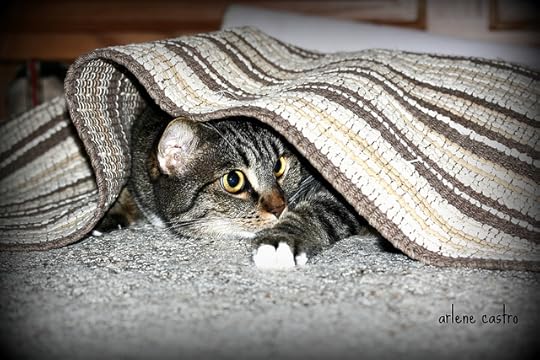
Kitties like Lady Tornado find entertainment if you don’t have time–that can be good! Or not… Image Copr. Arlene Castro
How To Properly Gift With A Pet
What if the kids, your spouse, Aunt Ethel, or a best friend have made it clear they want a pet, are prepared for the responsibility, and feel ready RIGHT NOW for a furry loved one in their life? You’re sure, and so are they. What can you do?
The professionals used to say that the holidays were a TERRIBLE time to get a new pet–that impulse adoptions could leave the cat or dog without a home after the cute-holiday-thrills wore off. More recently, though, the ASPCA conducted some surveys and discovered that when done properly, these adoptions can be lasting, loving adoptions. So I had to re-think my advice.
Holidays tend to be hectic times when normal routines go out the window. Whether a baby, adult or senior rescue cat or dog, new animals need the stability of knowing what to expect. In fact, some holiday schedules may allow you to be home more during this time to help the new kitty or pooch adjust.
I put together these important 4 STEPS FOR GIVING A PUPPY and they apply to kitty-gifting, too. Holiday pets take more work, true. But just think: you’re not only giving the pet to a person—you’re giving a special human to a waiting cat or dog, a fur-kid hungry for a loving, permanent home. Happy holidays, indeed!
Have you ever given–or received–a pet as a gift? How did you prepare? What was the result? Please share! I’m on the road this weekend but will check in and answer as much as I can, I’d love to hear your experiences.
I love hearing from you, so please share comments and questions. Do you have an ASK AMY question you’d like answered? Do you have a new kitten and need answers? Stay up to date on all the latest just subscribe the blog, “like” me on Facebook, listen to the weekly radio show, check out weekly FREE PUPPY CARE newsletter, and sign up for Pet Peeves newsletter. Stay up to date with the latest book give aways and appearances related to my THRILLERS WITH BITE!
Filed under: Cat Behavior & Care, Dog Training & Care Tagged: Amy Shojai, cat behavior, dog behavior, giving kittens. how to give pets as gifts, giving puppies, pets, pets as gifts, www.amyshojai.com


December 16, 2012
Monday Mentions: Parakeets, Driving Dogs & Bestseller Insight
I had this scheduled for Monday…but it has come out a day early. That’s fine. Unexpected happens and we must be prepared to deal with the good, bad and unbelievable.
As I was writing this, I watch the tragedy unfold in Connecticut and mourn the senseless loss of life. I’d already planned to include the link to this song, and somehow it now seems even more appropriate.
Stand By Me sung around the world, at the same time, thanks to a creative mix. May we all “stand” together against evil. Amen.
Monday Mentions is the mash-up-day of all the neato-torpedo writer links and videos, pet schtuff and bling and writer-icity crappiocca collected over the past week. Please scroll down for some silly, fun, and moving videos, too.
Writer-icity Schtuff
Zombies in Nature, this is so full of weird-icity and coolness, writers will eat it up with a spoon! Dibs on the concept, guys…
Author Branding Tips a great discussion
Facebook Changes Privacy Settings
NYT Separates Bestseller List for YA and MiddleGrade
Connect Google+ to Online Writing
How Bestseller Lists Work and learn about Amazon Monthly 100
Writer Beware-The Albee Agency Faked Publicity
When Life Gets In the Way boy, I can relate to this! Lovely post most of us can relate to
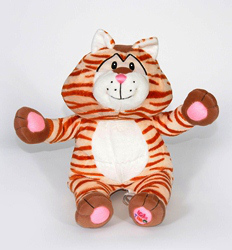
Help Kitten Associates donate a K.T. Cat plush toy to the kids of Sandy Hook.
Pet-centric Schtuff
Kittens for Kids of SANDY HOOK Kitten Associates is opening their doors, by appointment only, to residents in their community of Newtown, and especially in Sandy Hook, from Dec. 19 through Jan. 31 for some emotional healing through live “kitten therapy.” To set up a visit, request a free plush for your child, or to donate to the plush kitten purchase fund, interested parties should email Kitten Associates at info@kittenassociates.org or call 203-744-9CAT (9228).
Animals With Accents? fascinating. Take the test…I have a Midland accent, who knew?
Treat or Euthanize? some insights from the veterinary side
Muscle Transplant Returns Dog’s Mobility very cool procedure
Pedigreed Cats Friendlier Than “Mutt” Cats? My colleague Jo Singer reports…what do you think of this new study result?
Wilco, the Movie Trailer Pup some truly creative and fun short videos
Post-Traumatic Stress Disorder…In Dogs
Creative Cat Feeding from the wonderful cat behavior consultant Marilyn Krieger
Thanks to Piper Bayard for an alert about dog-driving videos–which Magic is not allowed to watch!
I love hearing from you, so please share comments and questions. Do you have an ASK AMY question you’d like answered? Do you have a new kitten and need answers? Stay up to date on all the latest just subscribe the blog, “like” me on Facebook, listen to the weekly radio show, check out weekly FREE PUPPY CARE newsletter, and sign up for Pet Peeves newsletter. Stay up to date with the latest book give aways and appearances related to my THRILLERS WITH BITE!
Filed under: Cat Behavior & Care, Dog Training & Care, Writing Advice & More Tagged: Amy Shojai, cat behavior, dog training, dogs driving cars, kittens, parakeet training, www.shojai.com


December 14, 2012
Holiday Sparkles, A Cat-Mas Story

16 year’s ago a furry waif came to live with us . . .
Crash-galumph-galumph-skiiiiiiid-thump!
“Amy! Will you please get your cat before she tears up the house?”
I sighed, and pushed away from the computer. My husband grew up cat-less. Mahmoud neither understood nor appreciated kitten antics, especially while he watched television sports.
Crash-galumph-galumph-skiiiiiiid-thump!
“Ameeeeeeee!”
By the sound of it, the eight-month-old delinquent had donned virtual racing stripes. She ran laps that traversed the carpeted living room and family room, slid across the oak floor entry, bumped down steps to the dining room, then finished with a claw-scrabbling turn around the slate-tiled kitchen.
Thumpa-thumpata-thumpa-THUMP!
Aha, a new path discovered . . . The sound grew louder as she raced toward me up the stairs and flew down the hallway to land tippy-toed on the guest bed across the hall from my office. I peeked inside.
Seren(dipity) stared back with blue-jean-colored eyes. Then she self-inflated in mock terror and began trampoline calisthenics (boing-boing-boing) on the mattress.
I quickly shut the door, confining the demon seed–my husband’s name for her–to my upstairs domain.
Back in June, a friend discovered the dumped kitten napping in an empty flowerpot on the back porch and called me, her pet-writer buddy, for help. I had been pet-less for longer than I cared to admit. E-mail, phone and fax lines kept me connected to my clients and colleagues, but I figured the kitten would brighten the long, sometimes lonely workdays. Besides, as a pet writer I needed a pet. So it was Amy-to-the-rescue, and love at first sight.
My husband wasn’t so easily smitten. He still missed our elderly and sedate German shepherd but cherished the freedom of being pet-less. I convinced him a lap-snuggling kitten would be no trouble. Besides, the cream-color carpet he’d chosen matched the color of Seren’s fur. It had to be an omen.
The cat gods have a wicked sense of humor. They made me pay for that fib.
The Siamese wannabe had no off-switch. She talked nonstop and demanded the last word. She opened drawers and explored kitchen cabinets. She answered my office phone but never took messages. And she left legions of sparkle ball toys everywhere.
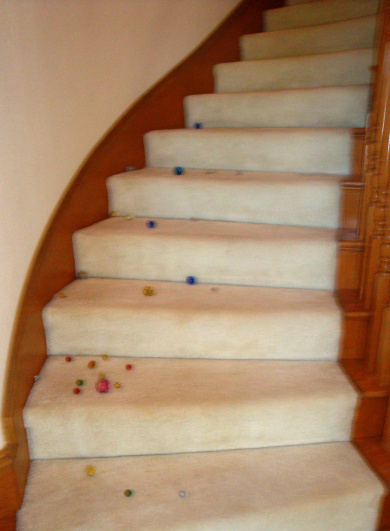
The colorful toys polka-dotted the stairs. You’d think a peacock threw up. The toys floated in the kitten’s water bowl, swirled in the toilet, and bobbed in my coffee cup. And Seren hid sparkle balls everywhere to later stalk and paw-capture them from beneath household appliances.
Mahmoud quickly learned to check his shoes each morning before putting them on. He was not amused. I knew better than to suggest he should be grateful Seren only stuffed his shoes with sparkle balls and not–ahem–other items.
I’d managed to buffer the cat-shock-effect over the past months by keeping her in my office during the day and wearing Seren out with lots of games before Mahmoud came home from work. Weekends proved a challenge. By Monday morning, my husband reached his kitty threshold and welcomed a return to the cat-free-zone at work.
But now the holidays loomed. Mahmoud looked forward to two weeks at home, two weeks of relaxation, two weeks of napping on the couch in front of the TV.
Two weeks sharing the house with “the devil.”
It would indeed be a Christmas miracle if we survived with sense of humor intact.
In the past we’d often visited my folks over the holidays where we enjoyed a traditional snowy Indiana Christmas morning, stocking stuffers, decorated tree, lots of relatives, and a sumptuous turkey dinner. This year we planned a quiet celebration at home in Texas, so snow wasn’t an option. But I wanted to decorate with lots of holiday sparkles to make the season as festive as possible.
“A Christmas tree? Don’t cats climb trees?” Mahmoud’s you-must-be-insane expression spoke volumes. He’d already blamed Seren for dumping his coffee on the cream-colored carpet. Maybe matching fur color wasn’t such a great omen after all.
But ‘tis the season of peace on earth, and I wanted to keep the peace–and the cat. So I agreed. No tree.
Mahmoud didn’t particularly care if we decorated at all since Christmas isn’t a part of his cultural or religious tradition. But he knew I treasured everything about the holidays. So we compromised.
Gold garland with red velvet poinsettias festooned the curving staircase, wrapping around and around the banisters and handrail. Gold beads draped the fireplace mantel, with greeting cards propped above. A red cloth adorned the dining room table, while in the living room, the candelabra with twelve scented candles flickered brightly from inside the fireplace. Other candles in festive holders decorated the several end tables, countertops and the piano.
The centerpiece of Christmas décor was the large glass-top coffee table placed midway between the fireplace, TV and the leather sofa. The wooden table base carried puppy teeth marks, silent reminders of the dog Mahmoud and I still mourned. Since we had no tree, the table served to display brightly wrapped packages that fit underneath out of the way. And on top of the table I placed Grandma’s lovely three-piece china nativity of Mary, Joseph and the Baby in the manger.
Grandma died several years before, right after the holidays. Each family member was encouraged to request something of hers to keep as a special remembrance, and I treasured Grandma’s nativity. The simple figurines represented not only the Holy Family but evoked the very essence of Grandma and every happy family holiday memory.
Of course, Seren created her own memories and put her paw into everything. It became her purpose in life to un-festoon the house. She “disappeared” three of the faux poinsettias, risked singed whiskers by sniffing candles, and stole bows off packages.
She decided the red tablecloth set off her feline beauty. She lounged in the middle of the table beneath the Tiffany-style shade that doubled as a heat lamp, shedding tiny hairs onto the fabric. As every cat lover eventually learns, fur is a condiment. But Mahmoud had not yet joined the cat-lover ranks and was not amused.
“Off! Get off the table. Amy, she’ll break your glass lampshade.”
Crash-galumph-galumph-skiiiiiiid-thump!
Mahmoud had no sooner resettled onto the sofa to watch the TV when the whirling dervish hit again. The twinkling gold beads dangling from the mantel caught her predatory attention. Seren stalked them from below, quickly realized she couldn’t leap that high, and settled for pouncing onto the top of the TV. From there, only a short hop separated her from the ferocious mantel quarry she’d targetted.
“Off! Get off the TV. Amy, will you come get your cat?”
Crash-galumph-galumph-skiiiiiiid-thump!
I arrived in time to see her complete a second Mario Andretti lap. I swear she grinned at us as she skidded past. With the next drive-by Seren stopped long enough to grab my ankle, execute a ten-second feline headstand while bunny-kicking my calves, then resumed her mad dash around the house.
Mahmoud glared. “I thought you said cats sleep sixteen hours a day.”
I shrugged and hid a smile. Seren had already learned what buttons to push. Rattling the wooden window blinds worked extremely well, but now she need only eye the decorations to garner all the attention she craved.
Cute kitty. Smart kitty. Mahmoud wasn’t amused, but I was.
She raced into the living room, leaped onto the glass top table, and belly-flopped alongside my treasured Holy Family . . .
“Off! Get off.” Mahmoud shooed the kitten out of the danger zone before I could react in shock. This time, I was not amused.
Mahmoud knew what Grandma’s nativity meant to me. “Decorating was your idea. Don’t blame me if the devil breaks something,” he warned.
Before he could suggest it, I caught the miscreant and gave her a time out in the laundry room to cool her jets. We’d relegated Seren’s potty, food bowls and bed to this room and routinely confined her at night or when away. Otherwise, she set off motion detectors and the house alarm–or dismantled the house while we slept. Besides, Mahmoud complained Seren’s purring kept him awake at night.
I used a wooden yardstick to fish toys from beneath the washer/dryer to provide necessary feline entertainment during the incarceration. Several dozen sparkle balls–red, orange, yellow, green, blue, pink, purple–and the three missing faux poinsettias emerged, along with an assortment of dust bunnies and dryer lint.
I sighed. The kitten’s age meant several more months of madcap activity and I wasn’t sure how much more Mahmoud could take. He only saw Seren at full throttle. He also suffered from “Saint Spot Syndrome” which meant he recalled only the happy memories of our beloved dog, and overlooked potty accidents, chewed shoes and other normal canine misbehaviors of the past.
Seren suffered mightily in the comparison.
I felt exhausted after the first week of running vacation interference between my husband and the kitten. Whenever possible I kept Seren confined with me in my upstairs office but that backfired. She slept in my office, but once downstairs she turned into a dynamo intent on pick-pick-picking at Mahmoud especially when he ignored her.
The second week began, and as Christmas drew near I found more and more errands that required my attention outside of the house. Mahmoud came with me for some, but other times he preferred TV.
“Just lock up the devil before you leave so she doesn’t bother me,” he said. “I don’t want to watch her.”
It made me nervous to leave them alone together in the house. I worried that Seren might commit some last straw infraction and I’d be unable to salvage any potential relationship. I loved her, heaven help me; she’d hooked her claws deep into my heart. And I loved Mahmoud. I wanted my two loves to at least put up with each other.
But as I prepared to leave I couldn’t find her. At less than five pounds, Seren could hide in the tiniest spaces. One time I found her inside the box springs of the guest bed, but that day–December 23rd–she disappeared and refused to come out of hiding.

I think she planned it. Maybe the spirit of the holidays inspired her. Or perhaps some other loving canine (or grandmotherly) influence worked its Christmas magic. Whatever the motivation, when I returned home that rainy December evening, my unspoken holiday wish had been granted.
I found my husband napping on the sofa. On the glass top table beside him the Holy Family nested in a radiance of sparkle balls–an inspired feline gift of toys for a very special Child.
And atop Mahmoud’s chest, quiet at last, rested a very happy kitten.
Mahmoud roused enough to open one eye. “Fafnir–I mean Seren still purrs too loud,” he grumbled.
Fafnir had been the name of our dog.
With a nod toward the overcast day Mahmoud added, “At least our cat won’t need to be walked in the rain.”
Seren blinked blue-jean-colored eyes and purred louder.
Note: This first appeared in a short story collection titled Christmas Cats: A Literary Companion (Chamberlain Bros. Publishing), and again here last year on the blog. May your Christmas be joyous, bright, and filled with loving woofs and purrs.
I love hearing from you, so please share comments and questions. Do you have an ASK AMY question you’d like answered? Do you have a new kitten and need answers? Stay up to date on all the latest just subscribe the blog, “like” me on Facebook, listen to the weekly radio show, check out weekly FREE PUPPY CARE newsletter, and sign up for Pet Peeves newsletter. Stay up to date with the latest book give aways and appearances related to my THRILLERS WITH BITE!
Filed under: Cat Behavior & Care Tagged: Amy Shojai, cat behavior, cat play, cats, Christmas, Holiday Sparkles story, kittens, www.amyshojai.com


December 13, 2012
Guest Post at Sheila Bonham’s Blog
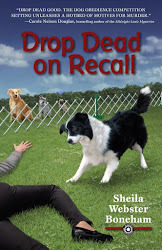 Yesterday I was bad. *hanging head* I almost forgot to send my guest post to the amazing talented dog mystery author Sheila Bonham’s WRITING ON WEDNESDAY blog. It’s been crazy, and I’ve had soooo many guest posts and special blogs scheduled that if she hadn’t sent me a gentle reminder, I’d have missed out altogether. So even though it’s a day late, I like to return the favor by a shout-out of warm wags and suchlike and send you to visit her terrific site.
Yesterday I was bad. *hanging head* I almost forgot to send my guest post to the amazing talented dog mystery author Sheila Bonham’s WRITING ON WEDNESDAY blog. It’s been crazy, and I’ve had soooo many guest posts and special blogs scheduled that if she hadn’t sent me a gentle reminder, I’d have missed out altogether. So even though it’s a day late, I like to return the favor by a shout-out of warm wags and suchlike and send you to visit her terrific site.
Sheila writes the new Animals In Focus mystery series, with the first book Drop Dead On Recall just recently released. I’ve known Sheila and admired her dog writing work for many years–we both started out with nonfiction and are members of the Dog Writers Association of America–and now International Thriller Writer debut authors. Anyway, my guest post is all about 7 TIPS FOR ACCIDENTAL WRITER SUCCESS.
Oh, and to top off this thrilling Thursday theme and in time for the holidays, sign up for a book give away (below). Happy to paw-tograph to the winners. And looky, there’s only a few signed up so far so your chances are pretty good.
Goodreads Book Giveaway

Lost And Found
by Amy Shojai
Giveaway ends December 25, 2012.
See the giveaway details
at Goodreads.
I love hearing from you, so please share comments and questions. Do you have an ASK AMY question you’d like answered? Do you have a new kitten and need answers? Stay up to date on all the latest just subscribe the blog, “like” me on Facebook, listen to the weekly radio show, check out weekly FREE PUPPY CARE newsletter, and sign up for Pet Peeves newsletter. Stay up to date with the latest book give aways and appearances related to my THRILLERS WITH BITE!
Filed under: Dog Training & Care, Writing Advice & More Tagged: Amy Shojai, dogs, Lost And Found, mysteries, Sheila Bonham, Thrillers, www.amyshojai.com


December 12, 2012
Cake & Authors & Books, Oh My!
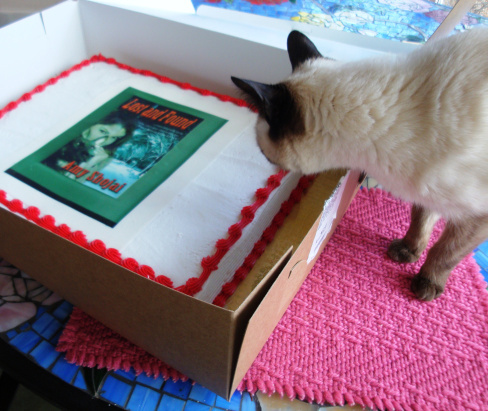
Seren thought the cake was for her! And she was considerate enough to try and taste-test before it was served to others.
Last Saturday evening I had my first ever book discussion group for LOST AND FOUND. We had a wonderful time and I wanted to share a couple of pictures of the fun cake made for the event.

Attendees got a “cutting” look at the cake and immediately understood the “point” I wanted to make because they are all “sharp” readers. *groan…*
Last Wednesday I shared with you my LOST AND FOUND/NEXT BIG THING blog hop. And today, the five authors I “tagged” last week have posted their own blogs you’ll want to check out, featuring new books. Just in time for the holidays, discover these great authors and books! Happy Writing and Reading!
Clea Simon writes awesome cat-centric mysteries and I know her through membership in the Cat Writers Association. Check out her great blog at Cats, Crime & Rock & Roll
Arden Moore, America’s Pet Edu-Tainer, writes terrific cat and dog care books, one of which was ranked #3 of ALL BOOKS on amazon! In a former life Arden was my editor, and we share a birthday (one month apart). She has some new books in the pipeline and blogs at Four Legged Life
Carol Shenold has been in my writers group for more than 20 years and is one of my dearest friends and a talented tech writer and novelist. She writes paranormal mysteries. Learn about her work and check out her Monster Under The Bed blog.
Check out Michael W. Sherer blog here. He writes terrific mysteries AND thrillers. I met him through Thriller Writers, and he invited me to participate in an AWESOME Kindle Fire give-away (plus some autographed books from famous thriller authors).
Victor DiGenti (writing as Parker Francis) publishes mysteries and has also written award-winning YA cat fantasy. Like Clea, we also met through Cat Writers Association.
I love hearing from you, so please share comments and questions. Do you have an ASK AMY question you’d like answered? Do you have a new kitten and need answers? Stay up to date on all the latest just subscribe the blog, “like” me on Facebook, listen to the weekly radio show, check out weekly FREE PUPPY CARE newsletter, and sign up for Pet Peeves newsletter. Stay up to date with the latest book give aways and appearances related to my THRILLERS WITH BITE!
Filed under: Writing Advice & More Tagged: Amy Shojai, Arden Moore, Carol Shenold, Clea Simon, Lost And Found, Michael W Sherer, Parker Francis, The Next Big Thing Blog, thriller, Victor DiGenti, writing, www.amyshojai.com


Cold Protection for Hot Dogs & Cats

Bruno enjoys a snowy day! Image Copr Dave M Hunt Photography
Do your fur-kids enjoy the cold weather? Or do they use shivery days to campaign for more lap time?
Magic loves seeing his breath and would spend lots more time outside–if his humans could stand it! Seren-kitty, though, is a heat seeking kitty and has staked out several warm nap spots throughout the house. What about your cats and dogs? Paws up, or down, to winter?
Sure, they have fur mufflers to keep icy winter blasts at bay. But pets risk cold weather dangers just as much as people do, and maybe even more. Because most folks have a warm place to retreat, and not all cats and dogs have this luxury. Others, like Magical-Dawg, may not have the sense to come in from the cold when they’d rather play in the frigid temps.
I grew up in Northern Indiana and hated the cold–I still do, although I do appreciate seeing a white Christmas (but from the view inside the house, LOL!). My thriller LOST AND FOUND takes place during a freak blizzard that puts a little boy and his service dog at risk for freezing to death. The main character September offers cold weather pet tips in a radio interview as the book opens. But I thought y’all might like some more of the furry de-tails (sorry, couldn’t resist!).
How Pets Stay Warm
Dogs and cats don’t benefit from gi-normous dog houses, and even the garage (unless it’s heated!) may not be protective. Instead, they curl up in small shelters that can be warmed by their own body heat.
Shelter from the wind and precipitation is vital. Fluffed fur traps warm air next to the skin in an insulating layer, but wind strips that away.Getting wet makes the cold worse, when fur can’t fluff to hold warm air. A twenty-mile-per-hour wind makes forty-degree weather feel like 18 degrees, more than enough to cause frostbite in an unprotected cat or dog.
Adult dog and cat body temperature ranges from about 100 to 102.5 degrees F. Puppies and kittens, though, have trouble maintaining body temperature. Newborn pups and kittens must pile together in furry bundles, or snuggle next to Mom–and if left alone, they can develop hypothermia and die even in mild weather. Huddling together shares warmth and reduces wind loss of heat, and shivering generates heat.
Shorthaired pets have less protection but even fuzzy critters are at risk. Thinly furred areas or body parts exposed to the wind or that come in contact with the icy ground have little protection from the cold.
Pets conserves heat by diverting blood circulation from the ear tips, toes and tail to protect the vital organs in the central part of the body. But reduced circulation to these extremities increases the chance for frostbite.
What Is Frostbite?
Tissue is 90 percent water. When frozen, cells rupture when the water expands just like ice cubes overflowing the tray. The resulting damage—termed frostbite—can be painful and severe.
Frostbite turns the skin pale white, gray or blue. Fur may hide the damage but you’ll notice pets limp from frozen toes, frozen ear tips or tails droop, and the skin will be very cold, hard, and nonpliable.
Redness, blisters, and serious infection develop days later. If it’s really severe, the affected tissue turns leathery and insensitive to sensation. If not removed surgically, those areas fall off. When I worked as a vet tech in Eastern Kentucky, we often had pet patients that lost parts of ears, toes and in one memorable case, an Elkhound lost his curled tail. All cases of frostbite need veterinary attention after first aid. You can learn more about pet frostbite and first aid tips here.
What Is Hypothermia?
While frostbite causes discomfort and damage to the extremities, hypothermia happens when overall body temperature falls below normal. In people hypothermia is defined as body temperature lower than 95 degrees, and treatment is vital to survival. When body temperature falls too low in pets, they can die.
Mild hypothermia happens if body temperature drops to between 95 to 99 degrees F. Pets act a bit sluggish and lethargic, and you’ll see muscle tremors and shivering. Moderate hypothermia is more serious when the temperature falls to 91 to 95 degrees. Severe hypothermia is body temperature 90 degrees or less, and is an emergency—take your pet to the veterinarian as soon as possible! Pets lose the ability to shiver if their body temperature falls to 90 degrees or below, so that’s a warning sign. They may fall unconscious, and rescue breathing may be necessary. Learn more about hypothermia and home first aid here.
The best protection is to provide shelter from the wet and cold. Bring outdoor cats and dogs inside during severe cold. Why not snuggle together, share body heat and protect each other safe from Old Man Winter’s dangers?
So how do you protect your pets from cold weather? Do tell!
I love hearing from you, so please share comments and questions. Do you have an ASK AMY question you’d like answered? Do you have a new kitten and need answers? Stay up to date on all the latest just subscribe the blog, “like” me on Facebook, listen to the weekly radio show, check out weekly FREE PUPPY CARE newsletter, and sign up for Pet Peeves newsletter. Stay up to date with the latest book give aways and appearances related to my THRILLERS WITH BITE!
Filed under: Dog Training & Care Tagged: Amy Shojai, dogs, first aid, frostbite, hypothermia, pets, www.amyshojai.com

December 10, 2012
Monday Mentions: Audio Kittens, Plush Pups & Writing Awesomeness

$500 drawing for posting! Click Banner to find out more!
Today I want to draw everyone’s attention to that big-a$$ banner at the top of the post–to get your name in the drawing, bloggers need to register to post about this very cool holiday book promo. I registered already. *s* Hey, who couldn’t use an extra $500 around the holidays?

I’ve got news! My book COMPLETE KITTEN CARE is now available as an audio book at Audible.com and I’m told will soon be available on iTunes and link to the Amazon Kindle version. Oh, and I narrated the book. Just in time for help with those holiday kittens…of course I hope y’all do everything right if you choose to adopt at this time of year. 

Also, I just read a delightful new book by a new author–I call it “Harry Potter with cat characters.” I love discovering great new reads, and although I don’t usually go for “talking cats” when they’re like humans with fur coats, this one really sucked me in. I’ve already invited Virginia to join CWA. You can check out my review of Apprentice Cat here.
Monday Mentions is the mash-up-day of all the neato-torpedo writer links and videos, pet schtuff and bling and writer-icity crappiocca collected over the past week. Check out the awesome links, below, and I’d love it if you’d post your own shout-outs about great books for the holidays in the comments section. Yes, this is permission to PIMP YOUR OWN/OTHERS WORK! Go for it!
WRITER-ICITY SCHTUFF
Password Scams some great info for everyone–but especially for evil-minded plot-driven writers. Hey, I’m going to use this!
Fundamentals Of A KickStarter Program we all need funding for our projects–but how to get crowd funding to work? Some tips here.
Is Amazon Killing Indie Publishing? insightful post, thanks to Diane Capri for sharing.
Amazon’s 2013 Breakout Novel Contest
Great Articles from ASJA for writers, of course. Lots to read here–thanks to Sally Bahner for the head’s up.
Writing Email Updates Fans Actually Read! another from Diane Capri (yes, you should be FB friending her!)
4 Ways Authors Sabotage Themselves on Facebook
Build Your Platform a review of a book on the subject that may prove helpful
Get Twitter Hashtags to Work For You and here’s another helpful article, thanks to Stacy Green Whisenand for the links
Best Biz Advice for Writers a roundup of AWESOME articles from Jane Friedman
PET-CENTRIC SCHTUFF
Dog Spotters a fun new app for iPad and iPhone that let’s you “collect” and learn about 200 dog breeds–if you enjoy bird watching, dog spotting will be the next new furry BIG THING! My colleague Caroline Coile had a paw in this creative fun hobby, check it out.
Pet Food Drive for the holidays . . . great endeavor. My church does this on the local level, providing our “soup kitchen” guests also with pet food for their furry companions–it frees up funds for other important items.
FreeKibble.com and FreeKibbleCat.com are more terrific venues for getting food to needy pets. Ellen DeGeneres is involved, of course, and the initiative will deliver 500,000 meals of all natural Halo Spot’s Stew to pets in need across the country.
Stephanie Piro’s Awesome Cat Cartoon Calendar is now available, you won’t want to miss this!

My colleague Cat Man Drew paints amazing cat works of art–Click the picture to check out his site for holiday gifts!
This video comes courtesy of Dakota’s Den blog and I just had to share!
I love hearing from you, so please share comments and questions. Do you have an ASK AMY question you’d like answered? Do you have a new kitten and need answers? Stay up to date on all the latest just subscribe the blog, “like” me on Facebook, listen to the weekly radio show, check out weekly FREE PUPPY CARE newsletter, and sign up for Pet Peeves newsletter. Stay up to date with the latest book give aways and appearances related to my THRILLERS WITH BITE!
Filed under: Cat Behavior & Care, Dog Training & Care, Writing Advice & More Tagged: Amy Shojai, audio books, cat behavior, Christmas pet gifts, Complete Kitten Care, dog training, pets, writing advice, www.amyshojai.com











